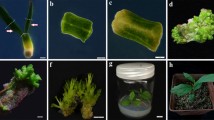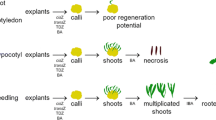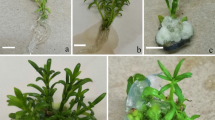Abstract
Direct in vitro plantlet regeneration was studied in cucumber (Cucumis sativus), an important vegetable crop. The endogenous auxin concentration was quantified by HPLC in young cotyledon explants, and we observed that higher auxin content promotes callusing and inhibits direct shoot regeneration. Lowering the endogenous auxin concentration by the application of the auxin inhibitor 2,3,5-triiodobenzoic acid (TIBA), as confirmed by HPLC, increased the frequency of shoot regeneration. The auxin content was reduced by increasing the concentration of TIBA in cvs. Pant Kheera 1 and Pusa Uday. Regeneration efficiencies were dependent on explant age and cultivar. The 2-d-old explants gave the highest regeneration efficiencies, with Pusa Uday showing higher regeneration potential than PK-1. Shoot buds/small shoots transferred to Murashige and Skoog (MS) medium supplemented with 1 μM 6-benzylaminopurine grew vigorously and attained 1- to 2-cm length in 4 wk. These shoots rooted with 100% efficiency on MS basal medium or MS basal medium supplemented with 0.5 μM indole-3-acetic acid. The hardened plants showed normal growth and flowering under greenhouse conditions.



Similar content being viewed by others
References
Barnes WC (1961) Multiple disease resistant cucumbers. Proc Am Soc Hortic Sci 77:417–423
Belaizi M, Paul H, Sangwan RS, Sangwan-Norreel BS (1991) Direct organogenesis from internodal segments of in vitro grown shoots of apple cv. Golden Delicious. Plant Cell Rep 9:471–474
Bergervoet JHW, Van der Mark F, Custers JBM (1989) Organogenesis versus embryogenesis from long-term suspension cultures of cucumber (Cucumis sativus L.). Plant Cell Rep 8:116–119
Bhau BS, Wakhlu AK (2001) Effect of genotype, explant type and growth regulators on organogenesis in Morus alba. Plant Cell Tissue Organ Cult 66:25–29
Bronsema FBF, van Oostveen WJF, van Lammeren AAM (2001) Influence of 2,4-D, TIBA and 3,5-D on the growth response of cultured maize embryos. Plant Cell Tissue Organ Cult 65:45–46
Burza W, Malepszy S, Rostek E (1995) An effect of simple and recurrent in vitro regeneration on cucumber inbred line under field cultivation. Hortic Sci 28:11–13
Cade RM, Wehner TC, Blazich FA (1988) Embryogenesis from cotyledon-derived callus of Cucumis sativus L. Cucurbit Genet Coop Rep 11:3–4
Cade RM, Wehner TC, Blazich FA (1990) Somatic embryos derived from cotyledons of cucumber. J Am Soc Hortic Sci 115:691–696
Chee PP (1990) High frequency somatic embryogenesis and recovery of fertile cucumber plants. Sci Hortic 25:792–793
Chee PP, Tricoli DM (1988) Somatic embryogenesis and plant regeneration from cell suspension cultures of Cucumis sativus L. Plant Cell Rep 7:274–277
Christopher T, Rajam MV (1994) In vitro clonal propagation of Capsicum spp. Plant Cell Tissue Organ Cult 38:25–29
Deakin JR, Bohn GW, Whitaker TW (1971) Interspecific hybridization in Cucumis. Econ Bot 25:195–211
Detrez C, Sangwan RS, Sangwan-Norreel BS (1989) Phenotypic and karyotypic status of Beta vulgaris plants regenerated from direct organogenesis in petiole culture. Theor Appl Genet 77:462–468
Esquinas-Alcazer JT, Gulick PJ (1983) Genetic resources of Cucurbitaceae. IBPGR, Rome
Ezuka A, Komkada H (1974) Varietal difference in resistance of cucumber to downy mildew. Bull Tokai-Kinki Agric Exp Station 27:42–45
Gambley RL, Dodd WA (1990) An in vitro technique for production of de novo of multiple shoots in cotyledon explants of cucumber (Cucumis sativus L.). Plant Cell Tissue Organ Cult 20:177–183
Handley LW, Chambliss OL (1979) In vitro propagation of Cucumis sativus L. Sci Hortic 14:22–23
Kim SG, Chang JR, Cha HC, Lee KW (1988) Callus growth and plant regeneration in diverse cultures of cucumber (Cucumis sativus L.). Plant Cell Tissue Organ Cult 12:67–74
Kim YJ, Oh YJ, Park WJ (2006) HPLC-based quantification of indole-3-acetic acid in the primary root tip of maize. J Nano Biotechnol 3:40–45
Lall S, Mandegaran Z, Roberts AV (2005) Shoot multiplication in cultures of mature Alnus glutinosa. Plant Cell Tissue Organ Cult 83:347–350
Lomax TL, Muday GK, Rubery PH (1995) Auxin transport. In: Davies PJ (ed) Plant hormones—physiology, biochemistry and molecular biology. Kluwer, Dordrecht, pp 509–530
Lou H, Kako S (1994) Somatic embryogenesis and plant regeneration in cucumber. Sci Hortic 29:906–909
Malepszy S (1988) Cucumber (Cucumis sativus L.). In: Bajaj YPS (ed) Biotechnology in agriculture and forestry: crops II. Springer, Berlin, pp 276–293
Malepszy S, Nadolska-Orczyk A (1983) In vitro culture of Cucumis sativus. I. Regeneration of plantlets from callus formed by leaf explants. Z Pflanzenphysiol 111:273–276
Malepszy S, Nadolska-Orczyk A (1989) In vitro culture of Cucumis sativus. VIII. Variation in the progeny of phenotypically not altered R1 plants. Plant Breed 102:66–72
Murashige T, Skoog F (1962) A revised medium for rapid growth and bioassays with tobacco tissue cultures. Physiol Plant 15:473–497
Rajasekaran K, Mulling MG, Nair Y (1983) Flower formation in vitro by hypocotyl explants of cucumber (Cucumis sativus L.). Ann Bot 52:417–420
Selvaraj N, Vasudevan A, Manickavasagam M, Ganapathi A (2006) In vitro organogenesis and plant formation in cucumber. Biol Plant 50:123–126
Selvaraj N, Vasudevan A, Manickavasagam M, Kasthurirengan S, Ganapathi A (2007) High frequency shoot regeneration from cotyledon explants of cucumber via organogenesis. Sci Hortic 112:2–8
Shifriss OC, Myers CH, Chupp C (1942) Resistance to the mosaic virus in the cucumber. Phytopathology 32:773–784
Singh SK, Syamal MM (2000) Anti-auxin enhance Rosa hybrida L. micropropagation. Biol Plant 43:279–281
Tabei Y (1997) Study on breeding of Cucurbitaceae using biotechnology. Bull Natl Inst Agrobiol Resour 11:1–107
Tabei Y, Kanno T (1989) Effect of three kinds of auxins on the regeneration of cucumber (Cucumis sativus L.). Bull Natl Res Inst Veg Ornamental Plants Tea Ser 3:97–105
Tetu T, Sangwan RS, Sangwan-Norreel BS (1987) Hormonal control of organogenesis and somatic embryogenesis in Beta vulgaris callus. J Exp Bot 38:506–517
Wehner TC, Locy RD (1981) Tissue culture propagation of field-grown cucumber selections. Cucurbit Genet Coop Rep 4:20–22
Ziv M (1992) Micropropagation of Cucumis spp. In: Bajaj YPS (ed) Biotechnology in agriculture and forestry: high-tech and micropropagation III. Springer, Berlin, pp 72–90
Ziv M, Gadasi G (1986) Enhanced embryogenesis and plant regeneration from cucumber (Cucumis sativus L.) callus by activated charcoal in solid/liquid double-layer cultures. Plant Sci 47:115–122
Acknowledgments
The authors thank Harshad Brahmbhatt for the assistance in HPLC analysis of the samples. The Analytical Discipline and Centralized Instrument Facilities are also duly acknowledged for providing the facilities. Financial assistance provided by a CSIR Empower project (OLP 0056) is gratefully acknowledged. P.S. Shukla is thankful to AcSIR for enrollment in the Ph.D. program.
Author information
Authors and Affiliations
Corresponding author
Additional information
Editor: Susan Murch
Electronic supplementary material
Below is the link to the electronic supplementary material.
ESM 1
(PPTX 107 kb)
Rights and permissions
About this article
Cite this article
Shukla, P.S., Das, A.K., Jha, B. et al. High-frequency in vitro shoot regeneration in Cucumis sativus by inhibition of endogenous auxin. In Vitro Cell.Dev.Biol.-Plant 50, 729–737 (2014). https://doi.org/10.1007/s11627-014-9649-6
Received:
Accepted:
Published:
Issue Date:
DOI: https://doi.org/10.1007/s11627-014-9649-6




